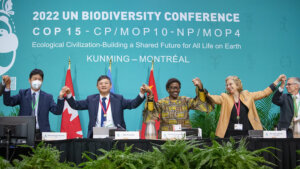From December 7 to 19, government leaders, activists, and Indigenous communities gathered in Montreal for COP15, the 2022 Biodiversity Conference. 12 days were dedicated to international negotiations and conversations on the preservation and restoration of land and marine ecosystems, with a key anticipated goal being a global framework for biodiversity. The summit’s headline goal was to codify a commitment from countries to preserve 30 percent of their land and water by 2030.
Biological diversity is the variation of life on Earth, forming the natural patterns and dynamics that connect us all (UN Environment Programme). Biodiversity is rapidly declining at unprecedented rates, with a million species (from birds, plants, mammals, reptiles, fish, and insects) at the brink of extinction (IPBES 2019). Biodiversity loss threatens the structures and relationships of ecosystems and gene composition of species and populations.
Global Biodiversity Outlook 5, published for the Convention on Biological Diversity (CBD) abridges recent research and data to summarise progress towards the Aichi Biodiversity Targets. These twenty targets, created at the CBD meeting in 2010, make up five Strategic Goals aimed at protecting and conserving global biodiversity. However, none of these targets had been fully achieved by the 2020 deadline. Meeting these targets are key to the 2030 Agenda for Sustainable Development and the Paris Agreement under the United Nations Framework Convention on Climate Change (GBO-5).
Officials planned to work together and create a plan to protect animals and ecosystems around the world. This discussion is crucial, as “Many experts call COP15 the last chance to reverse the decline of nature” (Vox).
A document called “Post-2020 Global Biodiversity Framework” was the expected outcome of the conference, if all negotiations went to plan. This would be the first framework devised since the 20 Aichi Biodiversity Targets. The document planned to lay out twenty-two quantifiable targets for nations to work towards and conserve ecosystems. The most notable target emerging from the document is known as “30×30,” or the goal to preserve 30% of land and sea areas by 2030, an increase from the current 15% of land and 7% of sea targets. Beyond 30×30, the document included other targets that will be up for discussion until the end of the conference.
From goals of cutting pesticide use, restoring degraded land and sea, promoting sustainable agriculture practices, or eliminating government subsidies on harmful industries, experts have many terms to negotiate in just two weeks.
In the latest draft of the Post-2020 Global Biodiversity Framework, the purpose and goals are to provide a more “outcome-oriented” framework, with four long-term goals for 2050 and 22 action-oriented targets for 2030.

One of the challenges that emerged at the COP15 negotiations was the disagreement on funding. UN donor funding for biodiversity is currently targeted at key regions to protect important global ecosystems. Nations like China, Brazil, India, Mexico and Indonesia currently receive the most funding from the Global Environment Facility (GEF). However, developed countries are arguing that countries like China and Brazil should be donating, rather than receiving funds. Additionally, other biologically important nations from Africa, Asia, and South America think they should be receiving more funds for conservation. In a new global fund for biodiversity, many countries, led by Brazil, India, Indonesia and Africa, are “calling in unison for financial subsidies of at least $100 billion a year, or 1% of global GDP until 2030” (Pressenza).
Another point of discussion at COP15 was the protection of Indigenous peoples and local communities (IPLCs). In the past, conservation efforts have been based on ‘“Fortress Conservation’, a model imposed in Africa and Asia during colonial times. It is founded on the racist idea that Indigenous people are primitive, that their knowledge is mere superstition, and they do not know how to take care of their environments” (African Arguments). Harmful rhetoric like this is being targeted and suppressed at COP15 with a “rights-based conservation” ideology, which means that IPLCs are seen as protectors of land.
After two weeks of negotiations, COP15, chaired by China, and hosted by Canada, came to a close on December 19, 2022. As the conference ended, the Kunming-Montreal Global Biodiversity Framework (GBF) was completed. The GBF will address four main goals:
- Halting human-induced extinction of species, reducing extinction rate and risk of all species tenfold by 2050, and maintaining and restoring natural ecosystems and genetic diversity
- Sustainable use and management of biodiversity
- Fair sharing and equity of the benefits from the utilization of genetic resources, digital sequence information on genetic resources, and traditional knowledge associated with genetic resources
- Adequate means of implementing the GBF be accessible to all Parties, particularly least developed countries and small island developing States.
The GBF also included 23 targets to achieve by 2030, including the most notable “30×30” goal that headlined the conference. Funding for developing countries was a critical component to the framework. Accordingly, the GBF Fund was set up by the Global Environment Facility to support the implementation of the GBF in all countries.
This framework is a significant step towards protecting life and biodiversity on land and in the oceans. Creating these goals is only the first step and putting them into action will be the hardest part. With the GBF established, each Party of the Convention will develop and adopt revisions to their National Biodiversity Strategies and Action Plans (NBSAPs), a tool for countries to reach the goals and targets and implement the framework nationally. As Inger Andersen, UNEP Executive Director said, “Success will be measured by our rapid and consistent progress in implementing what we have agreed to. The entire UN system is geared to support its implementation so we can truly make peace with nature.”



